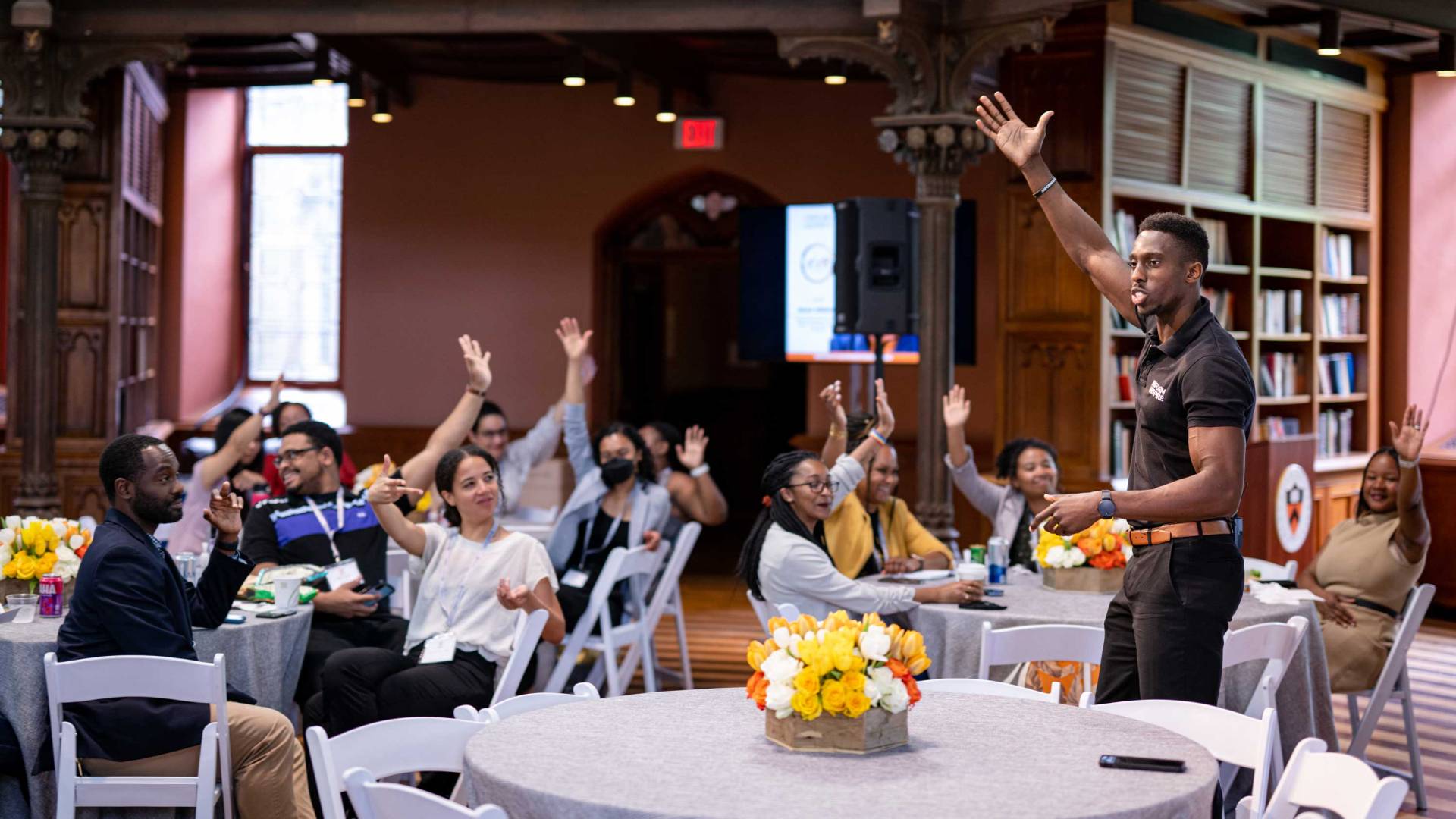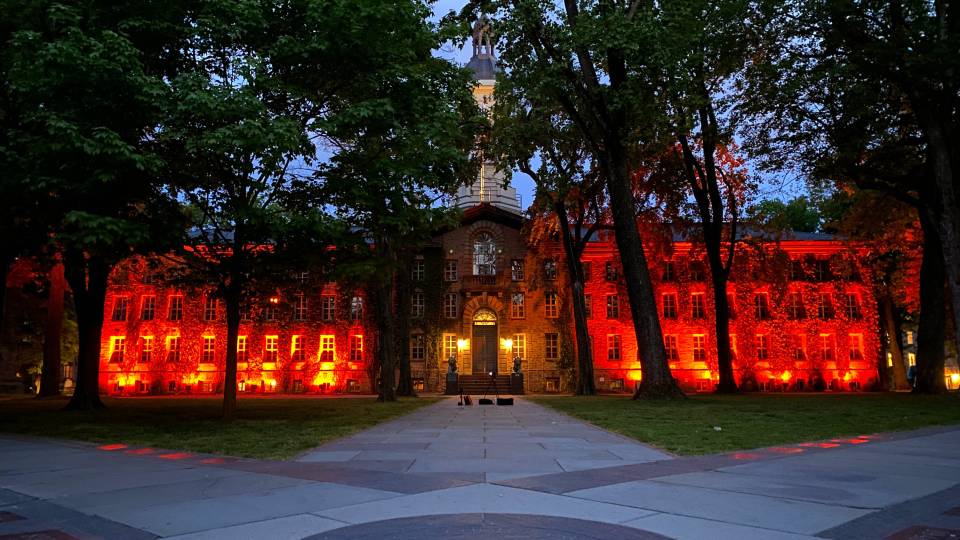The Graduate School held its first Inclusive Academy Symposium in spring 2022.
The University has released its second annual diversity, equity and inclusion report, which highlights how Princeton is working to be even more diverse, inclusive and accessible in ways that enrich the quality of teaching and research and improve campus climate. The report summarizes many events, programs and initiatives during the 2021-22 academic year, and also includes demographic and climate data about students, staff, faculty, postdoctoral scholars and academic professionals.

Princeton first-year students attend Orientation on campus.
“Princeton’s dedication to excellence requires sustained commitments to diversity, equity and inclusion,” President Christopher L. Eisgruber wrote in the report. “We must seek out and support the talent that exists in every sector of society, bringing together people of many groups and identities and enabling them to thrive fully on campus and beyond it.”
In 2020, Eisgruber established a University-wide effort to find additional ways to promote equity within the University and society as a whole, and to redouble past efforts to make Princeton a more diverse, inclusive and equitable community.
“Supporting talent from all backgrounds constitutes a long-term investment in teaching, research and innovation that benefits our country and the world,” Eisgruber said in a video introducing the diversity, equity and inclusion report. “Our scholarly and teaching excellence demand nothing less.”
Vice Provost for Institutional Equity and Diversity Michele Minter said she hopes this year’s report conveys “the many ways that Princetonians have taken initiative and challenged themselves and others in order to strengthen our scholarship, teaching and communal life.”
For example, the 2021-22 report notes progress on recent faculty recruitment efforts, including the appointment of the inaugural vice dean for diversity and inclusion in the Office of the Dean of the Faculty.
The report also highlights important milestones, such as the 50th anniversaries of kosher dining on campus, the Gender and Sexuality Resource Center (formerly the Women*s Center), and the Carl A. Fields Center for Equality and Cultural Understanding (formerly the Third World Center).
The report’s data section was enhanced this year to better reflect the diversity of the University community. Self-reported racial and ethnic detail data for faculty, staff and students, and self-disclosed gender identity and sexual orientation data for students now “more accurately reflect the richness of identities represented in the campus community,” according to Shawn Maxam, associate provost for diversity and inclusion.

Members of the Class of 2022 celebrate their Commencement.
“Feedback was sought from across the University community regarding how we can, as a community, better hold ourselves accountable,” Maxam added. He said the annual report is part of a commitment toward greater accountability and transparency, and also helps the University evaluate its progress.
This year’s report represents a continuation of efforts, not a conclusion, said Maxam. Goals for the 2022-23 academic year including Cabinet officers (the University’s senior leaders) updating their cross-institutional action plans, developing a diversity, equity and inclusion data framework to inform University data collection, and expanding diversity, equity and inclusion training resources and infrastructure.
To read the full report online or download the PDF, visit the Office of Institutional Equity and Diversity site. The report does not include every event, program or project from the 2021-22 year, and updates about ongoing efforts are available on the Racial Equity website, where feedback about the University’s work can also be submitted.
A few highlights from the 2021-22 report’s three topic areas are below; please read the report for the full scope of diversity, equity and inclusion updates.
Climate, inclusion and equity highlights:
- Laura Wooten Hall was dedicated and new portraits were added to the University’s campus collection to better reflect the diversity of Princeton’s building names and iconography.
- More than 100 staff and students completed training on Jewish identity and anti-Semitism.
- The Asian and Asian American Alumni organization celebrated its 40th anniversary with a yearlong series of engagements.
- Human Resources organized more than 120 diversity, equity and inclusion workshops for staff.
- A new parent and caregiver employee resource group was established.
- The Graduate School launched the Inclusive Academy Symposium and Best of Access, Diversity and Inclusion Awards.
Academic experience highlights:
- The Office of the Dean of the Faculty appointed the inaugural vice dean for diversity and inclusion.
- The School of Public and International Affairs appointed its inaugural associate dean of diversity, equity and inclusion.
- The Princeton Alliance for Collaborative Research and Innovation launched a partnership with Historically Black Colleges and Universities and the United Negro College Fund.
- Princeton’s Effron Center for the Study of America was established.
- American Sign Language (ASL) was approved to fulfill the undergraduate language requirement.
- A new webpage launched with resources related to academic freedom and freedom of expression.
Access and outreach highlights:
- The University increased graduate fellowship and stipend rates by an average of 25% for doctoral candidates.
- The Community College Teaching Partnership and Community College Teaching Program was expanded.
- The University began a significant expansion of its undergraduate transfer student population.
- The inaugural vice provost for academic affairs was appointed to identify opportunities to leverage Princeton’s mission and resources to support nontraditional students.
- The inaugural associate director for supplier diversity was appointed to support the Office of Finance and Treasury’s multi-year supplier diversity action plan.
- An elevator was installed in Nassau Hall and a new campus wayfinding system was launched to improve campus accessibility.






